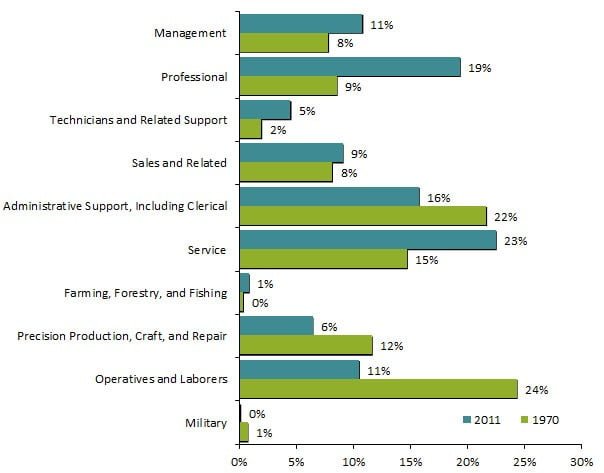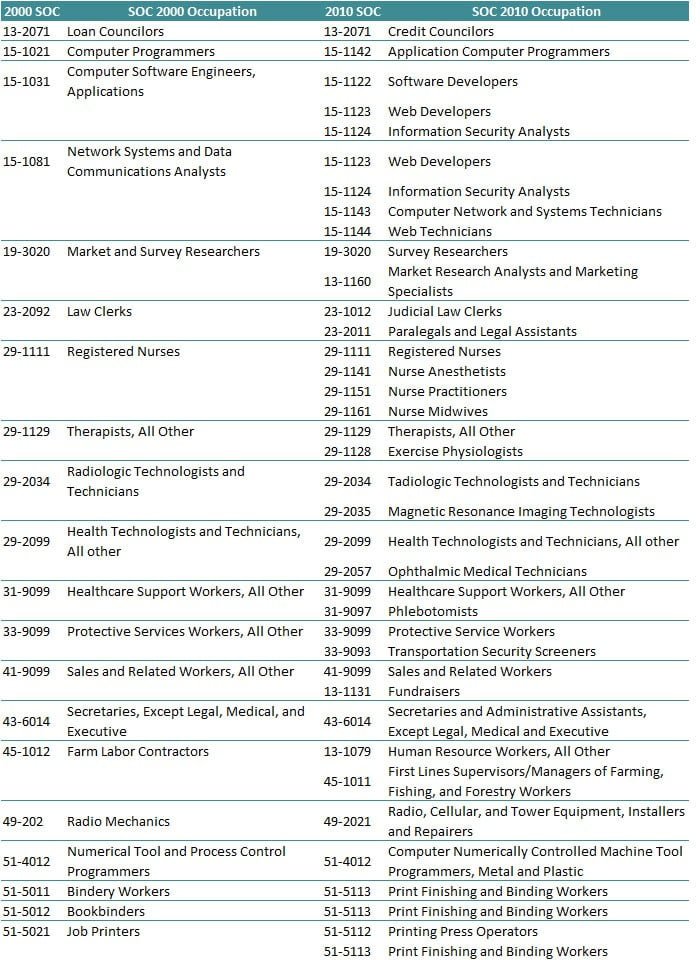The occupations held by Philadelphians has changed significantly in the last 40 years. These shifts from manufacturing production, extraction, and labor in transportation and machine operations declined significantly, while occupations in professional and service-related industries notably increased. In 2011 Philadelphia residents ages 16 and over worked in the following occupations:
EMPLOYMENT BY OCCUPATIONAL GROUP IN PHILADELPHIA COUNTY IN 2011 (PERCENT OF TOTAL EMPLOYMENT)

Source: U.S. Census Bureau, the 2009-2011 American Community Survey. Employment status filter was applied to the data, eliminating individuals not actively employed.
Changes in the occupations since 1970 to 2011 are shown in the chart below. As the Census Bureau modified occupational definitions across time, comparisons required a reconciliation of codes. While the complete reconciliation of codes is not possible, IPUMS method was used for the comparison that allows to bridge codes from different classification systems. Because of the definitional changes, comparisons show trends in shifts in employment by occupational family rather than actual changes in employment.
Operation and Laborers and Precision Production, Craft, and Repair, and Administrative Support occupations declined since 1970, while Professional and Service occupations increased in volume. Occupations that decreased as a proportion of total employment tend to be concentrated in industries that also experienced decline, such as Manufacturing, Transportation, and Construction. Occupations that increased by volume tend to be clustered in industries with increases in employment. Some occupations declined as the nature of tasks within occupations changed as some tasks were mechanized and others were shared with other occupations.
Operatives and Laborers occupations employing 24 percent of Philadelphians such as machine operators and transportation workers in 1970 decreased in volume by over half. In 1970, 1 in 10 workers were employed in in some production-related occupations (Precision Production, Craft, and Repair) but since then the occupational group decreased in volume by nearly half as well. Administrative Support and Clerical workers decreased from 22 percent of total employment in 1970 to 16 percent in 2011.
Professional occupations and Service occupations grew in volume from 1970 to 2011. Professional occupations that include computer and mathematical professionals, engineers, natural scientists, health diagnosing occupations, therapists, teachers, and art and media occupations among major subgroups increased in volume 1.5 times. Service occupations that include private household workers, protective service workers, food preparation workers, and personal service workers, increased in volume by half its size.
EMPLOYMENT BY OCCUPATIONAL GROUP IN PHILADELPHIA COUNTY: 1970 VS. 2011 (PERCENT OF TOTAL EMPLOYMENT)

Source: U.S. Census Bureau, the 2009-2011 American Community Survey, the 1970 Census; tables were prepared using IPUMS online data analysis system. Occupational definitions changed from 1970 to 2011 and IPUMS crosswalk method was used to align the classifications across time. Chart displays percent of total employment. Employment status filter was applied to the data, eliminating individuals not actively employed.
Changing Definitions of Occupations 2000-2010
Standard Occupational Classification (SOC) is a system used for classifying all occupations in the U.S. economy. The classification categorizes occupations on the basis of their similarities into 23 major groups and 840 broad occupations. Emerging occupations continually refine and expand our ideas about work. The 2000 Standard Occupational Classification was revised for 2010 to reflect changes in the work itself, the language used, or the relationship to other occupations. For example:
- Changes in Information Technology resulted in several revisions to the Computer Software Engineers, Application (15-1031) occupation, which was split into three new occupations. Other occupations were combined into one, for example Binder Workers (51-5011) and Bookbinders (51-5021) were combined into one occupation, Print Finishing and Binding Workers (51-5113).
- Several occupations went through title changes, including Loan Counselors (13-2071) which were renamed as Credit Counselors.
- It was determined that Flight Attendants (53-2031) perform work that is more related to the work of other transportation workers, so this occupation was moved from the major group of Personal Care and Service occupations into Transportation and Material Moving occupations.
The Standard Occupational Codes were updated most recently in 2010. All changes from 2000-2010 are described in the table below.
CHANGES IN OCCUPATIONS REFLECTED IN THE 2010 STANDARD OCCUPATIONAL

Source: the BLS 2010 SOC list of occupations can be found in What’s New in the 2010 SOC publication.




